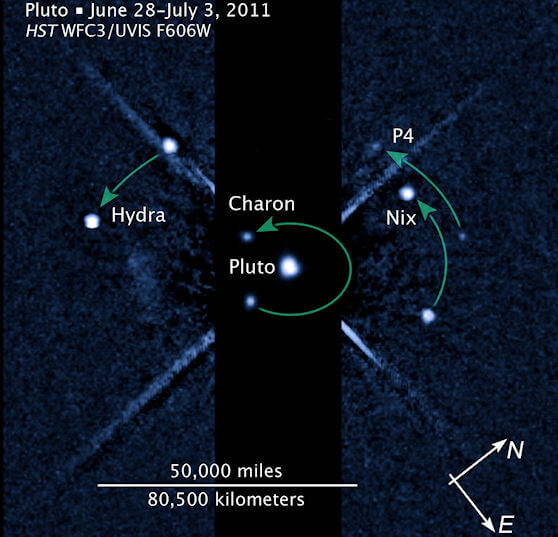The moon was discovered as part of the Pluto system observations project, which aims to help plan the journey of the New Horizons spacecraft during its transit through the Pluto system in 2015

Astronomers using the Hubble Space Telescope have discovered a fourth moon orbiting the dwarf planet Pluto. The tiny moon - temporarily known as P4 - appeared in Hubble's survey looking for rings around the dwarf planet.
The new moon is the smallest yet discovered around Pluto. It is difficult to know exactly its diameter but it is estimated between 13 and 34 kilometers. By comparison, the diameter of Charon, Pluto's largest moon, is 1,043 kilometers and the other moons Nix and Hydra are between 32 and 113 kilometers in diameter.
"I find it impressive that the Hubble cameras were able to allow us to see such a small object clearly from over 5 billion kilometers away," said Mark Showalter of the ST Institute in Mountain View, California, who led the observing program for the Hubble.
The findings are the result of ongoing work in support of NASA's New Horizons mission, which is scheduled to fly by Pluto in 2015. The mission was designed to provide new insights into the worlds at the edge of the solar system. The mapping of Pluto's surface by Hubble and the discovery of its moons are very important for the planning of the New Horizons approach mission to Pluto.
"This is a great discovery," says New Horizons project principal investigator Alan Stern of the Southwest Research Institute in Boulder, Colorado. "Now that we know there is another moon in the Pluto system, we can focus our observations on it during the flyby."
The orbit of the new moon lies between the orbits of Nix and Hydra, the moons that Hubble discovered in 2005. Charon was discovered in 1978 by the US Naval Observatory and was first clearly imaged in 1990 by Hubble as a separate body from Pluto.
The dwarf planet Pluto's moon system is hypothesized to have formed in a collision between Pluto and a similar-sized body in the early history of the solar system. The collision caused a flight of materials that joined the family of satellites observed orbiting Pluto.
Moon rocks brought to Earth by the Apollo missions have led to the theory that our Moon was formed as a result of a collision between Earth and a Mars-sized body 4.4 billion years ago. The scientists believe that the moons are bombarded by the impact of micro meteorites originating from the ring surrounding Pluto, but in the images taken by the Hubble no such ring has been discovered so far.
"This surprising observation is a strong reminder of Hubble's ability as a multipurpose astronomical observatory to make exciting discoveries," said John Morse, director of the Astrophysics Division at NASA's Washington Headquarters.
P4 was first seen in an image taken by Hubble's Wide Field Camera 3 on June 28. It was confirmed by repeated observations on July 3 and 18. The moon was not visible in previous photos because the exposure times in these photos were shorter. There is a chance that it appeared as a smear in the 2006 images that was mostly obscured by other bodies.

8 תגובות
What are Clapper's Laws, can you please explain
The star was not discovered because its diameter is so small as it says in the article!
And asteroids that are close to us can be seen like the asteroid that will pass by us in 2029 and probably also on Saturday 2036-7
Almond,
Look at something in the room you are in, for example a chair. If you put it 5 meters away, you will probably be able to see it. If you put it 5 km away, you might recognize it as a tiny dot. If you put it 5 billion km away, you probably won't see it with the naked eye.
Tell me what happened???
Do you need Hubble to discover new moons for Pluto?
To that extent have NASA become opaque and do not know what is going on in our solar system?
Most of the stars were already discovered at the dawn of civilization and now another moon is discovered for Pluto
And a few months ago it was published about another possible planet in the solar system that revolves around the sun (I'm not talking about predictions for 2012)
What can I tell you, if this is really what NASA knows, that is, what they reveal to us is all of NASA's knowledge, an asteroid could come tomorrow and no one would have a clue!
Does anyone know if Kepler's laws hold in the Pluto system?
Since it stopped being a planet it turns out that it has a lot of moons... as far as I understand it is the non-planet with the most moons so far?
Very cool